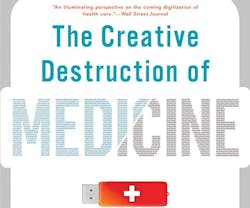There’s a revolution coming. We suggest you get ahead of it and make sure you pick up founder of Scripps Translational Science Institute Dr. Eric Topol’s two books: The Creative Destruction of Medicine and The Patient Will See You Now. While digitization has affected every other facet of our lives, our healthcare is the final frontier. The relationship between doctor and patient is about to change dramatically, in turn greatly affecting healthcare spaces. What does it mean for the industry when most consumers can gather routine lab work on their own? Topol has the answers…
interiors+sources: What was the inspiration for your books?
Dr. Eric Topol: I’ve been a physician and cardiologist for nearly three decades and I saw this remarkable, unprecedented change in opportunity for a whole different practice of medicine that was very much datafied and science/evidence-based, with people generating their own data. So the first book was about digitizing human beings, and then the second book was the next step. Once you have data that is imminently portable and being generated by people themselves, that sets up the foundation for democratizing medicine.
We’re going through the biggest shakeup in the history of medicine. I wanted to try to help pull that together so that particularly consumers and readers of the books would be aware of this, what I call the great inversion of medicine. Doctors used to be the high priests. Now it’s the bottoms up. Now any consumer can be very active in terms of taking charge of their care.
i+s: What will the doctor/patient relationship look like in the future because of these movements?
ET: It will be the patient/doctor relationship. Instead of the patient being in the last seat of the plane, they’ve been upgraded to being the co-pilot. That’s the power of information. That’s happening, but it’s not being promoted or embraced by doctors who don’t want to lose control. But it’s an inevitable path.
i+s: How will this affect the design and build of healthcare spaces?
ET: There won’t be so many visits to a doctor’s office because telemedicine is starting to surge in use and it’s much more efficient and cheaper. Instead of waiting 2.6 weeks to see a doctor, you’re seeing one in the middle of the night in a flash.
The doctor’s need will be different. Instead of the doctor being the one to order tests to get data, the patient is generating their own with the use of computers and machines, showing up to the doctor or through a teleconsole, presenting the data, and asking what they think in terms of treatment and accuracy/soundness of data. It’s a whole different role than it is today.
i+s: What products are out there now that are helping facilitate this power shift?
ET: It’s amazing the amount of innovation and ingenuity that’s moving forward. There are seemingly endless smartphone labs you can do with just a droplet of blood. You will be able to do all routine blood tests with a smartphone over the next couple of years. You can do all the leads of a cardiogram through your fingers on your phone. You can check glucose levels on your watch or phone every five minutes. You can also diagnose sleep apnea with an app at home without having to go to a hospital sleep lab. You can check the ear infection of your child through your smartphone. This is all through proven attachments or sensors.
We’re also quickly moving to moderating our blood pressure constantly. We’re working on ways to track the state of mind and mood through multiple different sensors. The number one cause of disability is depression, so we could hopefully quantify that for the first time for people and give them feedback as to what’s helping to raise their spirits and deduce the toll of a mental health burden.
At Scripps we do validation of technologies such as these that others have developed. We’re aggregating the info and developing the algorithms to process that data. We perform randomized trials with clinical outcomes to validate that these are accurately collecting data and changing outcomes for patients.
i+s: How can designers accommodate this huge shift in the healthcare industry?
ET: Read The Patient Will See You Now. It’s important to support this because it’s the future of medicine.
About the Author
AnnMarie Martin
Editor-in-Chief
AnnMarie is the former Editor in Chief of i+s and has been covering the commercial design space. Her style and vision has helped the brand evolve into a thought leader in purpose-driven design and cultural movements shaping the way we live and work.

